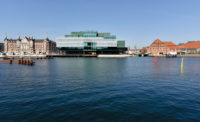It goes without saying that building bridges connects things, both literally and figuratively. The 11th Street Bridge Park in Southeast Washington, D.C., attempts to do much more. Its designer, OMA, together with landscape architect OLIN, sees it as a place of exchange —and its X shape, rising like criss-crossing springboards over the Anacostia River, will offer various indoor and outdoor spaces for the ambitious programs planned, including an environmental education center, performance venue, café, and an open plaza for markets and festivals. “Our hope is that the shape is iconic but also inviting,” says OMA partner Jason Long. “We want to create an inclusive place where people feel welcome.”
In this case, the bridge connects two disparate neighborhoods that for years have been separated by a racial and income divide—the Navy Yards on one side of the river, currently witnessing intense commercial and residential development, and the historically black neighborhood of Anacostia on the other.
While owned by the District Department of Transportation—the project will be built over existing piers from a disused overpass—the park will be run by the nonprofit Building Bridges Across the River (BBAR) and funded through a combination of private and localgovernment contributions. A feasibility report is currently being prepared, which includes load testing of the piers (the project is expected to complete in late 2019). Additionally, BBAR created an Equitable Development task force to help ensure that the 11th Street Bridge Park will spur inclusive development.
Waterfalls at either end of the crossing’s upper extensions are planned as prominent features that will simultaneously be attractors, sound buffers, and cooling devices. The eastern one will also help with river-water filtration. Together with other ecological features along and under the bridge, such as the wetlands that frame its piers, the filtration system will work to help clean the river and serve as an important symbol of its renaissance. According to OMA, the full integration of architecture, landscape, and infrastructure allows the creation of a socially and environmentally sustainable civic experience.










